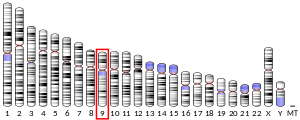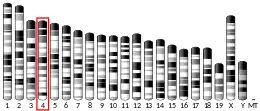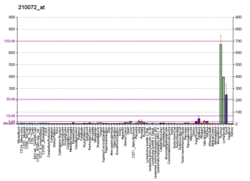Chemokine (C-C motif) ligand 19 (CCL19) is a protein that in humans is encoded by the CCL19 gene.[5][6]
This gene is one of several CC cytokine genes clustered on the p-arm of chromosome 9. Cytokines are a family of secreted proteins involved in immunoregulatory and inflammatory processes. The CC cytokines are proteins characterized by two adjacent cysteines. The cytokine encoded by this gene may play a role in normal lymphocyte recirculation and homing. It also plays an important role in trafficking of T cells in thymus, and in T cell and B cell migration to secondary lymphoid organs. It specifically binds to chemokine receptor CCR7.[6]
Chemokine (C-C motif) ligand 19 (CCL19) is a small cytokine belonging to the CC chemokine family that is also known as EBI1 ligand chemokine (ELC) and macrophage inflammatory protein-3-beta (MIP-3-beta). CCL19 is expressed abundantly in thymus and lymph nodes, with moderate levels in trachea and colon and low levels in stomach, small intestine, lung, kidney and spleen.[7] The gene for CCL19 is located on human chromosome 9.[8] This chemokine elicits its effects on its target cells by binding to the chemokine receptor chemokine receptor CCR7.[7] It attracts certain cells of the immune system, including dendritic cells and antigen-engaged B cells,[9][10] CCR7+ central-memory T-Cells.[11]
References
- ^ a b c GRCh38: Ensembl release 89: ENSG00000172724 - Ensembl, May 2017
- ^ a b c GRCm38: Ensembl release 89: ENSMUSG00000118633 - Ensembl, May 2017
- ^ "Human PubMed Reference:". National Center for Biotechnology Information, U.S. National Library of Medicine.
- ^ "Mouse PubMed Reference:". National Center for Biotechnology Information, U.S. National Library of Medicine.
- ^ Yoshida R, Imai T, Hieshima K, Kusuda J, Baba M, Kitaura M, Nishimura M, Kakizaki M, Nomiyama H, Yoshie O (Jul 1997). "Molecular cloning of a novel human CC chemokine EBI1-ligand chemokine that is a specific functional ligand for EBI1, CCR7". J Biol Chem. 272 (21): 13803–9. doi:10.1074/jbc.272.21.13803. PMID 9153236.
- ^ a b "Entrez Gene: CCL19 chemokine (C-C motif) ligand 19".
- ^ a b Yoshida R, Imai T, Hieshima K, Kusuda J, Baba M, Kitaura M, Nishimura M, Kakizaki M, Nomiyama H, Yoshie O (1997). "Molecular cloning of a novel human CC chemokine EBI1-ligand chemokine that is a specific functional ligand for EBI1, CCR7". J. Biol. Chem. 272 (21): 13803–9. doi:10.1074/jbc.272.21.13803. PMID 9153236.
- ^ Rossi DL, Vicari AP, Franz-Bacon K, McClanahan TK, Zlotnik A (1997). "Identification through bioinformatics of two new macrophage proinflammatory human chemokines: MIP-3alpha and MIP-3beta". J. Immunol. 158 (3): 1033–6. PMID 9013939.
- ^ Robbiani DF, Finch RA, Jäger D, Muller WA, Sartorelli AC, Randolph GJ (2000). "The leukotriene C(4) transporter MRP1 regulates CCL19 (MIP-3beta, ELC)-dependent mobilization of dendritic cells to lymph nodes". Cell. 103 (5): 757–68. doi:10.1016/S0092-8674(00)00179-3. PMID 11114332. S2CID 15592251.
- ^ Reif K, Ekland EH, Ohl L, Nakano H, Lipp M, Förster R, Cyster JG (2002). "Balanced responsiveness to chemoattractants from adjacent zones determines B-cell position". Nature. 416 (6876): 94–9. doi:10.1038/416094a. PMID 11882900. S2CID 4403093.
- ^ Bromley SK, Thomas SY, Luster AD (2005). "Chemokine receptor CCR7 guides T cell exit from peripheral tissues and entry into afferent lymphatics". Nat. Immunol. 6 (9): 895–901. doi:10.1038/ni1240. PMID 16116469. S2CID 443455.
Further reading
- Weber C, Koenen RR (2006). "Fine-tuning leukocyte responses: towards a chemokine 'interactome'". Trends Immunol. 27 (6): 268–73. doi:10.1016/j.it.2006.04.002. PMID 16678487.
- Rossi DL, Vicari AP, Franz-Bacon K, et al. (1997). "Identification through bioinformatics of two new macrophage proinflammatory human chemokines: MIP-3alpha and MIP-3beta". J. Immunol. 158 (3): 1033–6. PMID 9013939.
- Nagira M, Imai T, Hieshima K, et al. (1997). "Molecular cloning of a novel human CC chemokine secondary lymphoid-tissue chemokine that is a potent chemoattractant for lymphocytes and mapped to chromosome 9p13". J. Biol. Chem. 272 (31): 19518–24. doi:10.1074/jbc.272.31.19518. PMID 9235955.
- Kim CH, Pelus LM, White JR, et al. (1998). "CK beta-11/macrophage inflammatory protein-3 beta/EBI1-ligand chemokine is an efficacious chemoattractant for T and B cells". J. Immunol. 160 (5): 2418–24. PMID 9498785.
- Yanagihara S, Komura E, Nagafune J, et al. (1998). "EBI1/CCR7 is a new member of dendritic cell chemokine receptor that is up-regulated upon maturation". J. Immunol. 161 (6): 3096–102. PMID 9743376.
- Gosling J, Dairaghi DJ, Wang Y, et al. (2000). "Cutting edge: identification of a novel chemokine receptor that binds dendritic cell- and T cell-active chemokines including ELC, SLC, and TECK". J. Immunol. 164 (6): 2851–6. doi:10.4049/jimmunol.164.6.2851. PMID 10706668.
- Annunziato F, Romagnani P, Cosmi L, et al. (2000). "Macrophage-derived chemokine and EBI1-ligand chemokine attract human thymocytes in different stage of development and are produced by distinct subsets of medullary epithelial cells: possible implications for negative selection". J. Immunol. 165 (1): 238–46. doi:10.4049/jimmunol.165.1.238. PMID 10861057.
- Ueno T, Hara K, Willis MS, et al. (2002). "Role for CCR7 ligands in the emigration of newly generated T lymphocytes from the neonatal thymus". Immunity. 16 (2): 205–18. doi:10.1016/S1074-7613(02)00267-4. PMID 11869682.
- Phillips R, Ager A (2002). "Activation of pertussis toxin-sensitive CXCL12 (SDF-1) receptors mediates transendothelial migration of T lymphocytes across lymph node high endothelial cells". Eur. J. Immunol. 32 (3): 837–47. doi:10.1002/1521-4141(200203)32:3<837::AID-IMMU837>3.0.CO;2-Q. PMID 11870628.
- Till KJ, Lin K, Zuzel M, Cawley JC (2002). "The chemokine receptor CCR7 and alpha4 integrin are important for migration of chronic lymphocytic leukemia cells into lymph nodes". Blood. 99 (8): 2977–84. doi:10.1182/blood.V99.8.2977. PMID 11929789.
- Townson JR, Nibbs RJ (2002). "Characterization of mouse CCX-CKR, a receptor for the lymphocyte-attracting chemokines TECK/mCCL25, SLC/mCCL21 and MIP-3beta/mCCL19: comparison to human CCX-CKR". Eur. J. Immunol. 32 (5): 1230–41. doi:10.1002/1521-4141(200205)32:5<1230::AID-IMMU1230>3.0.CO;2-L. PMID 11981810.
- Page G, Lebecque S, Miossec P (2002). "Anatomic localization of immature and mature dendritic cells in an ectopic lymphoid organ: correlation with selective chemokine expression in rheumatoid synovium". J. Immunol. 168 (10): 5333–41. doi:10.4049/jimmunol.168.10.5333. PMID 11994492.
- Katou F, Ohtani H, Nakayama T, et al. (2003). "Differential expression of CCL19 by DC-Lamp+ mature dendritic cells in human lymph node versus chronically inflamed skin". J. Pathol. 199 (1): 98–106. doi:10.1002/path.1255. PMID 12474232. S2CID 25424987.
- Strausberg RL, Feingold EA, Grouse LH, et al. (2003). "Generation and initial analysis of more than 15,000 full-length human and mouse cDNA sequences". Proc. Natl. Acad. Sci. U.S.A. 99 (26): 16899–903. doi:10.1073/pnas.242603899. PMC 139241. PMID 12477932.
- Scandella E, Men Y, Legler DF, et al. (2004). "CCL19/CCL21-triggered signal transduction and migration of dendritic cells requires prostaglandin E2". Blood. 103 (5): 1595–601. doi:10.1182/blood-2003-05-1643. PMID 14592837.
- Corcione A, Arduino N, Ferretti E, et al. (2004). "CCL19 and CXCL12 trigger in vitro chemotaxis of human mantle cell lymphoma B cells". Clin. Cancer Res. 10 (3): 964–71. doi:10.1158/1078-0432.CCR-1182-3. PMID 14871974.
- Daikoku N, Kitaya K, Nakayama T, et al. (2004). "Expression of macrophage inflammatory protein-3beta in human endometrium throughout the menstrual cycle". Fertil. Steril. 81 Suppl 1: 876–81. doi:10.1016/j.fertnstert.2003.09.036. PMID 15019823.
- Gerhard DS, Wagner L, Feingold EA, et al. (2004). "The Status, Quality, and Expansion of the NIH Full-Length cDNA Project: The Mammalian Gene Collection (MGC)". Genome Res. 14 (10B): 2121–7. doi:10.1101/gr.2596504. PMC 528928. PMID 15489334.
- Paoletti S, Petkovic V, Sebastiani S, et al. (2005). "A rich chemokine environment strongly enhances leukocyte migration and activities". Blood. 105 (9): 3405–12. doi:10.1182/blood-2004-04-1648. PMID 15546958.




